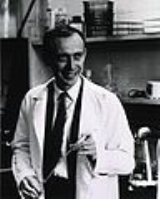
James D. Watson
Overview
James Dewey Watson is an American molecular biologist
, geneticist
, and zoologist, best known as one of the co-discoverers of the structure of DNA
in 1953 with Francis Crick
. Watson, Crick, and Maurice Wilkins
were awarded the 1962 Nobel Prize in Physiology or Medicine
"for their discoveries concerning the molecular structure of nucleic acid
s and its significance for information transfer in living material". After studies at the University of Chicago
and Indiana University
, he worked at the University of Cambridge
's Cavendish Laboratory
in England, where he first met his future collaborator and friend Francis Crick
.
In 1956, Watson became a junior member of Harvard University
's Biological Laboratories, holding this position until 1976, promoting research in molecular biology.
Molecular biology
Molecular biology is the branch of biology that deals with the molecular basis of biological activity. This field overlaps with other areas of biology and chemistry, particularly genetics and biochemistry...
, geneticist
Genetics
Genetics , a discipline of biology, is the science of genes, heredity, and variation in living organisms....
, and zoologist, best known as one of the co-discoverers of the structure of DNA
DNA
Deoxyribonucleic acid is a nucleic acid that contains the genetic instructions used in the development and functioning of all known living organisms . The DNA segments that carry this genetic information are called genes, but other DNA sequences have structural purposes, or are involved in...
in 1953 with Francis Crick
Francis Crick
Francis Harry Compton Crick OM FRS was an English molecular biologist, biophysicist, and neuroscientist, and most noted for being one of two co-discoverers of the structure of the DNA molecule in 1953, together with James D. Watson...
. Watson, Crick, and Maurice Wilkins
Maurice Wilkins
Maurice Hugh Frederick Wilkins CBE FRS was a New Zealand-born English physicist and molecular biologist, and Nobel Laureate whose research contributed to the scientific understanding of phosphorescence, isotope separation, optical microscopy and X-ray diffraction, and to the development of radar...
were awarded the 1962 Nobel Prize in Physiology or Medicine
Nobel Prize in Physiology or Medicine
The Nobel Prize in Physiology or Medicine administered by the Nobel Foundation, is awarded once a year for outstanding discoveries in the field of life science and medicine. It is one of five Nobel Prizes established in 1895 by Swedish chemist Alfred Nobel, the inventor of dynamite, in his will...
"for their discoveries concerning the molecular structure of nucleic acid
Nucleic acid
Nucleic acids are biological molecules essential for life, and include DNA and RNA . Together with proteins, nucleic acids make up the most important macromolecules; each is found in abundance in all living things, where they function in encoding, transmitting and expressing genetic information...
s and its significance for information transfer in living material". After studies at the University of Chicago
University of Chicago
The University of Chicago is a private research university in Chicago, Illinois, USA. It was founded by the American Baptist Education Society with a donation from oil magnate and philanthropist John D. Rockefeller and incorporated in 1890...
and Indiana University
Indiana University
Indiana University is a multi-campus public university system in the state of Indiana, United States. Indiana University has a combined student body of more than 100,000 students, including approximately 42,000 students enrolled at the Indiana University Bloomington campus and approximately 37,000...
, he worked at the University of Cambridge
University of Cambridge
The University of Cambridge is a public research university located in Cambridge, United Kingdom. It is the second-oldest university in both the United Kingdom and the English-speaking world , and the seventh-oldest globally...
's Cavendish Laboratory
Cavendish Laboratory
The Cavendish Laboratory is the Department of Physics at the University of Cambridge, and is part of the university's School of Physical Sciences. It was opened in 1874 as a teaching laboratory....
in England, where he first met his future collaborator and friend Francis Crick
Francis Crick
Francis Harry Compton Crick OM FRS was an English molecular biologist, biophysicist, and neuroscientist, and most noted for being one of two co-discoverers of the structure of the DNA molecule in 1953, together with James D. Watson...
.
In 1956, Watson became a junior member of Harvard University
Harvard University
Harvard University is a private Ivy League university located in Cambridge, Massachusetts, United States, established in 1636 by the Massachusetts legislature. Harvard is the oldest institution of higher learning in the United States and the first corporation chartered in the country...
's Biological Laboratories, holding this position until 1976, promoting research in molecular biology.
Discussions
Quotations
No one may have the guts to say this, but if we could make better human beings by knowing how to add genes, why shouldn't we?![]()
"Risky Genetic Fantasies" in The Los Angeles Times, p. M4 (29 July 2001)

